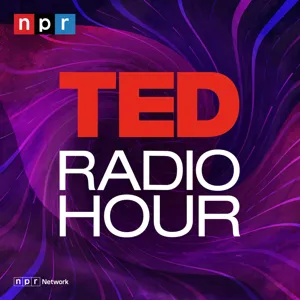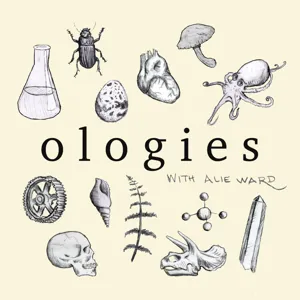Podcast Summary
New discoveries in space and the power of gravitational waves: Five years after exploring space on Ted Radio Hour, new discoveries include the first image of a black hole made possible by gravitational waves, revealing important information about the universe's history and origins.
Our understanding of the universe continues to expand with new discoveries and advancements in technology. Five years ago, we explored the wonders of space on the Ted Radio Hour, and since then, there have been significant discoveries, such as the first image of a black hole. This discovery, made possible by gravitational waves, allows us to see back in time and unlock mysteries of the origins of our universe. Theorist Alan Adams, who studies gravitational physics, explains that gravitational waves are ripples in space caused by massive disturbances. These waves have the potential to reveal important information about the universe, including the history of collisions that occurred long ago. Our curiosity about space remains ignited, and the possibilities for discovery continue to expand.
Detection of a Neutron Star Collision through Gravitational Waves: In 2017, scientists detected gravitational waves from a neutron star collision, providing insights into the number, mass, and distance of the involved objects, and the destructive power of such events.
The collision of two neutron stars, which occurred 130 million years ago, was detected on Earth in 2017 through the discovery of gravitational waves. These waves were created as the two objects spiraled closer to each other due to the emission of gravitational waves caused by their movement through space. The detection of these waves provided valuable information about the collision, including the number and mass of the objects involved, the amount of matter destroyed, and the distance to the event. The technology used to detect these waves, LIGO, is a testament to human ingenuity and perseverance, as it took decades to build and required a significant investment of resources. The discovery of gravitational waves opens up a new way of observing the universe and understanding the physical processes that shape it.
Discovering new things about the universe with gravitational waves: Gravitational waves allow us to learn unimaginable things about the universe, including measuring the Hubble constant, putting constraints on the acceleration of the universe, and potentially observing the Big Bang
The detection of gravitational waves by LIGO has opened up a new way to observe the universe, allowing us to learn unbelievable things about the universe that were previously unimaginable. No one expected to find gravitational waves, but since their discovery, we have detected numerous events and made groundbreaking discoveries, including measuring the Hubble constant and putting constraints on the acceleration of the universe. This is significant because it provides a completely independent measure of the acceleration of the universe, confirming that it is expanding at a faster and faster pace every moment. Additionally, gravitational waves may help us observe the very first event in the universe, the Big Bang, which is currently obscured by its own afterglow. The challenge now is to continue pushing the boundaries of what we can learn through gravitational waves and be as audacious as possible in our exploration of the universe.
Exploring the mysteries of the universe through gravitational waves: Gravitational waves offer a glimpse into the universe's past and future, expanding our knowledge and reminding us of its vastness and beauty.
Gravitational waves, which have been detected by observatories like LIGO, offer a unique opportunity to peer into the early universe and understand its origins, despite the fact that the Big Bang itself is opaque due to the extreme heat. This discovery not only sheds light on the universe's past but also provides insights into its future expansion. Furthermore, astrophysicists like Alan Adams and Sarah Seger are driven by the fascination of the cosmos and the desire to explore its mysteries, from the discovery of gravitational waves to the search for planets with potential for life beyond Earth. These discoveries not only expand our knowledge but also remind us of the vastness and beauty of the universe.
Exploring the vast universe and its planets: The universe is filled with billions of stars, each potentially having planets. While our solar system has eight, other solar systems could have more habitable planets with varying conditions.
Our solar system is just one small part of a vast universe filled with hundreds of billions of stars, each potentially having planets. While our solar system has eight planets, the number of planets in other solar systems could be much greater. The search for habitable planets, or "Goldilocks planets," is ongoing, but the reality is that these planets could have vastly different conditions compared to Earth. For instance, some planets might have extreme temperatures or atmospheres that act as giant blankets, making the planet uninhabitable despite being in the habitable zone. The discovery of such planets is just the beginning of our understanding of the diverse range of planets in our universe.
Discovering an Earth-like planet would lead to advancements in various scientific fields: The discovery of an Earth-like planet would bring about significant advancements in scientific research, including the search for extraterrestrial intelligence and the acceleration of probe development.
While the search for an Earth-like planet continues, the discovery would bring about significant advancements in various scientific fields. If we were to find such a planet, scientists would focus on providing concrete evidence and proof to the world. SETI would listen for extraterrestrial intelligence signals, and probe development would accelerate. The discovery would galvanize many different groups of people, leading to a surge in research and exploration. Despite the uncertainty of when we might find an Earth-like planet, the motivation to do so remains strong. Astrophysicists like Sarah Seeger and radio astronomers like Natasha Hurley Walker are using advanced tools like radio telescopes to explore the universe beyond what our eyes can see, expanding our understanding of the vastness of the cosmos.
Observing the universe's expansion through blue and red shifts: Advanced radio telescopes and supercomputers help uncover hidden galaxies and phenomena in the expanding universe by studying red shifts and blue shifts
As objects move towards or away from us in the universe, their light or sound waves change in wavelength and appearance. This phenomenon is known as the blue shift and red shift. The universe is expanding, causing everything to move away from each other, resulting in a red shift and eventual invisibility in the infrared. To study beyond this limit, we use radio telescopes, which can penetrate the infrared contamination. The technology has improved significantly with advancements in computing, allowing for more complex telescope designs and image processing. Natasha Hurley Walker and her team have used these advanced radio telescopes and supercomputers to discover hidden galaxies and phenomena, like the massive jets in Centaurus A.
Discovering Black Holes and Expanding Our Cosmic Understanding: A recent survey revealed 300,000 radio galaxies, pushing our understanding of the universe beyond the 'light horizon'. Though we can't see beyond this limit, scientists believe the universe may be much larger, potentially infinite.
Our universe is filled with millions to billions of distant galaxies, each with a supermassive black hole at its center. These black holes are invisible but their effects, such as accretion disks and powerful jets, can be detected through various forms of electromagnetic radiation. A recent survey discovered 300,000 of these radio galaxies, pushing our understanding of the cosmos further than ever before. However, there are limits to what we can observe, as we are unable to see beyond the "light horizon," which is about 13.7 billion light years in radius. Despite this, scientists believe the universe may be much larger than what we can observe, potentially even infinite in size. This discovery of black holes and the expanding scope of our understanding is an exciting time for science, with both large collaborative projects and small, innovative teams making significant contributions.
First Image of a Black Hole Reveals New Insights: Scientists collaborated to capture the first image of a black hole, revealing an accretion disk and deepening our understanding of these mysterious objects.
Black holes, despite being massive and ubiquitous in the universe, are still widely misunderstood. They are not just "giant train pipes" sucking up everything indiscriminately, but rather, they are spinning objects that keep things from falling in due to their associated energy. Last year, we captured the first image of a black hole, located at the heart of galaxy M87, using a massive collaboration of scientists, telescopes, and technology. This breakthrough required overcoming various challenges, including synchronizing telescopes and dealing with atmospheric interference. The image revealed a ring of light, called an accretion disk, surrounding the black hole. This discovery not only deepened our understanding of black holes but also showcased the incredible power of scientific collaboration and innovation.
New image of a black hole reveals uneven light distribution and spin: The new image of a black hole shows the uneven distribution of light around it, caused by the black hole's spin and gravity, allowing researchers to study space-time curvature and other aspects of general relativity.
The new image of a black hole reveals the uneven distribution of light around the absence of light in the center, caused by the spinning black hole's gravitational pull. This discovery, based on Einstein's theory of general relativity, allows researchers to study the spin of black holes, space-time curvature, and other intricacies of general relativity. The image also provides a glimpse into the exotic physics that occurs near a black hole, where intense gravity can cause extreme effects such as being stretched out or squashed. Despite the fantasies of traveling into a black hole, the reality is that it would not be a pleasant experience. Overall, this new image of a black hole marks a significant advancement in our understanding of these mysterious phenomena and the fundamental laws of physics.
Exploring the vastness of the universe and our place in it: The universe is vast and complex, with our galaxy being just one among billions. Our existence is put into perspective, emphasizing the importance of understanding and exploring the mysteries of the universe.
We live in a vast and expanding universe, with our galaxy being just one among billions. If you could travel to a black hole, you would be entering the realm of philosophy, beyond the reach of a physicist like me. Our galaxy, the Milky Way, contains a hundred billion stars and is a hundred thousand light years wide. We're just 30,000 light years from its central point and orbit around it every 200 million years. Yet, our galaxy is just one among the countless others in the universe. This perspective puts our existence into a larger context, highlighting the importance of exploring and understanding the mysteries of the universe. To learn more about the wonders of the universe and other thought-provoking ideas, tune in to the TED Radio Hour or visit TED.com. And remember, every city has individuals struggling with severe mental illness, and the podcast "Lost Patience" sheds light on the complex system for treating it, inviting us to imagine a better future for those in need.





